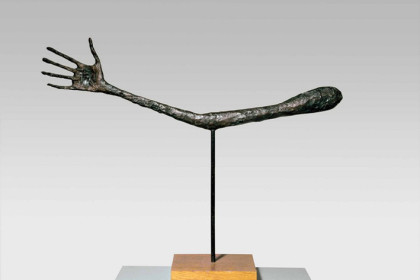
It is the reconstruction of a corner of New York that welcomes visitors to the exhibition Giacometti. The sculpture at Galleria Borghese in Rome. There are three figures commissioned in 1960 – Standing Woman I, Great Woman II, Man Walking I – intended to be placed in front of the sixty-storey skyscraper in the Chase Manhattan Plaza.
Alberto Giacometti (1901-1966), who since very young moved from his native Switzerland to Paris, he is widely considered one of the most significant sculptors of the twentieth century with its dramatic and inimitable style, he broke the conventions of classical figure through a training who approached him first to Cubism, and then he espoused the cause of Surrealism and finally develop his own models which represent human being. Very stretched sculptures, almost threadlike but composed of a defeat and “clotted” material which, while in slenderness take strongly possession of the space. They contain in themselves all existentialist problems, all reflection on the tragedy of life and the conflict between man and modernity. No coincidence that the artist, in his mature years, established a deep dialogue with Sartre.
The exhibition in Rome reconstructs the entire career of dreamy, visionary Giacometti: from the early essential and abstract sculptures of thirties, defined invisible objects and clearly indebted to Picasso as Braque, to the latest famous works, conveyed in the halls of Galleria Borghese by all major collections around the world. The great charm that comes from exposure derived from the relationship that is created between the old museum’s permanent works and those of the sculptor. Carefully designed combinations that introduce a precious harmony, dialogue between sculpture born in different centuries and forms that to a first glance do not seem to have a point of contact, but which instead seem to converse with affinity and affection with each other. Then the white sinuous Femme couchée qui rêve(1929) approaches the Pauline by Canova, the famous Homme qui marche 1947 calls the same step of Aeneas, which advances under the weight of Anchises (1619), the unstable equilibrium Homme qui chavire(1950) is off-axis as that of David by Bernini ( 1623/1624 ). Still, Giacometti makes extreme the process of stylization of the female bodies in a metamorphosis similar to that of Bernini’s Daphne turning into a tree.
Giacometti’s works on display are 40: bronze, plaster, designs that trigger synapse between the ancient and the modern, which allow you to perceive the depth of living subjects, the desire to dig up the soul to “cut to the bone” human shape, to bring to the surface the anxiousness, the frailty and the manifestation of humanity, with desperate strength and dignity in the world.
Edited by Anna Coliva and Christian Klemm
Rome, Galleria Borghese
Until May 25th, 2014
 English
English  Italiano
Italiano 



